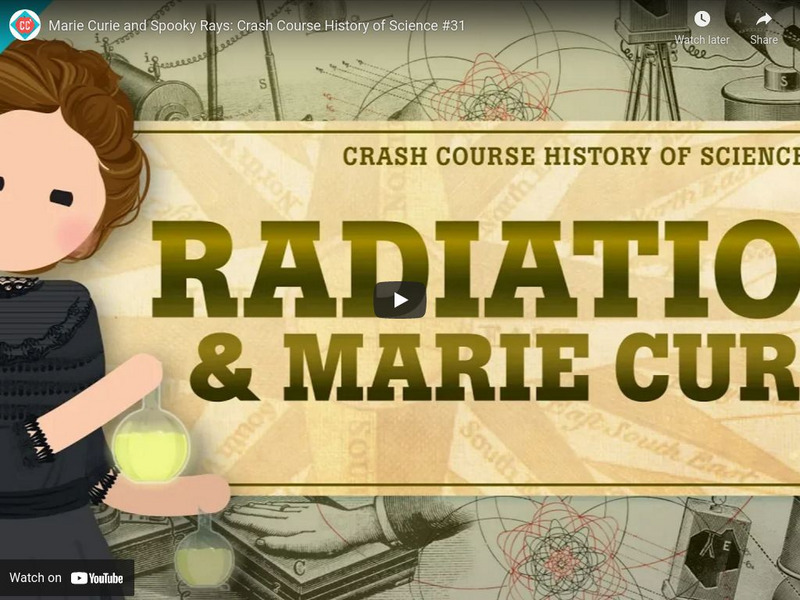Hi, what do you want to do?
JFR Science
Isotopes and Half-Life: What Are Medical Isotopes?
How do medical professionals use radiation without doing more harm than good? Budding nuclear chemists begin their study of all things radioactive with a video from the JFR Science playlist. Topics include differences between isotopes,...
Teacher's Pet
Radiation and Radioactivity
Explore the science of radioactivity! A very thorough video lesson begins with an explanation of the chemical structure of radiation. It includes descriptions of benefits of radioactivity and half-life calculations.
MinuteEarth
Why is it Hot Underground?
The deeper the mine shaft, the hotter the inside temperature, but why is that? The video explores different theories about the temperature of the earth through time. The discovery of radiation altered scientists' views, but mysteries...
TED-Ed
The Genius of Marie Curie
Can you name the only person to win two Nobel Prizes in two different sciences? After watching a short video on the life, discoveries, and accomplishments of Marie Curie, you can!
Fuse School
How the Elements are Laid Out in the Periodic Table
When scientists confirm new elements, do these elements always fit in on the periodic table where scientists expect? The second video in a series of 15 discusses how the elements are organized on the periodic table. The resource...
TED-Ed
History’s Deadliest Colors
Zounds! Who'da thunk it? Colors can be deadly. Viewers learn about the dangers of white (lead), green (radium and cupric hydrogen arsenic), and orange (uranium oxide) pigments used in clothing, ceramics, and home decor.
TED-Ed
What Are the Challenges of Nuclear Power?
Engineering challenges, construction costs, and disasters are some of the challenges when it comes to nuclear energy. Watch a video that explains each of these and more in detail.
Educreations
Stability
Teach the concept of stability in relation to nuclear chemistry with an instructional video that discusses the band of stability as well as radioactivity. Scholars examine the existence of different decay modes and how they develop.
Bozeman Science
A Tour of the Periodic Table
The major groups on the periodic table and their general properties based on their electrons are the focus of a video that also explains why the table is drawn in two parts and which elements are crucial to life.
TED-Ed
The Most Radioactive Places on Earth
Who receives that greatest amount of radioactive exposure? After visiting some of the most radioactive places on earth, including Chernobyl and Fukushima, viewers consider the exposure of radiation workers, astronauts, and cancer...
DoodleScience
Nuclear Radiation
Viewers learn about both natural and synthetic radiation in a video that discusses background radiation from cosmic rays, as well as from radioactive waste, radioactive fallout, and x-rays. It concludes with an explanation of alpha,...
Educreations
Uses of Radioactivity
Radioactivity is often perceived as dangerous and a threat to our well-being, but you may be surprised at the different applications of this natural chemical process. From the smoke detectors in our homes to treatments for cancer,...
Curated OER
Radioactive Isotopes
A Geiger counter is used to detect emission of alpha particles, beta particles, and gamma rays. The teacher experiments to find out which materials block each of these forms of radiation. The camera is focused on the measuring instrument...
Curated OER
Carbon Dating - How Does It Work?
For the first two minutes of this video, space-age narration and computer animation illuminate the science behind carbon dating. The presentation then switches gears and uses simple graphics and another narrator to explain the same...
Minute Earth
Minute Earth: Why Is It Hot Underground?
During the Middle Ages miners began to notice that the deeper they dug into the Earth's surface the warmer it became. The physicist Kelvin came up with a theory that the Earth's started off hot and has been cooling down ever since....
Crash Course
Crash Course Physics #45: Nuclear Physics
It's time for our second to final Physics episode. So, let's talk Einstein and Nuclear Physics. What does E=MC2 actually mean? Why is it so useful to us as physicists and humans? In this video episode of Crash Course Physics, Shini sits...
Crash Course
Crash Course History of Science #31: Marie Curie and Spooky Rays
It's time to talk about one of the most awesome scientists: Marie Curie. She figured out ways to get an education despite limitations of her homeland, was the first woman to win a Nobel Prize, and was the first person to win two Nobel...





















